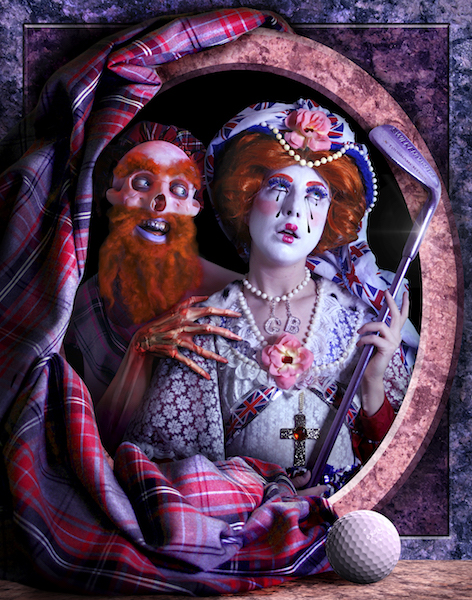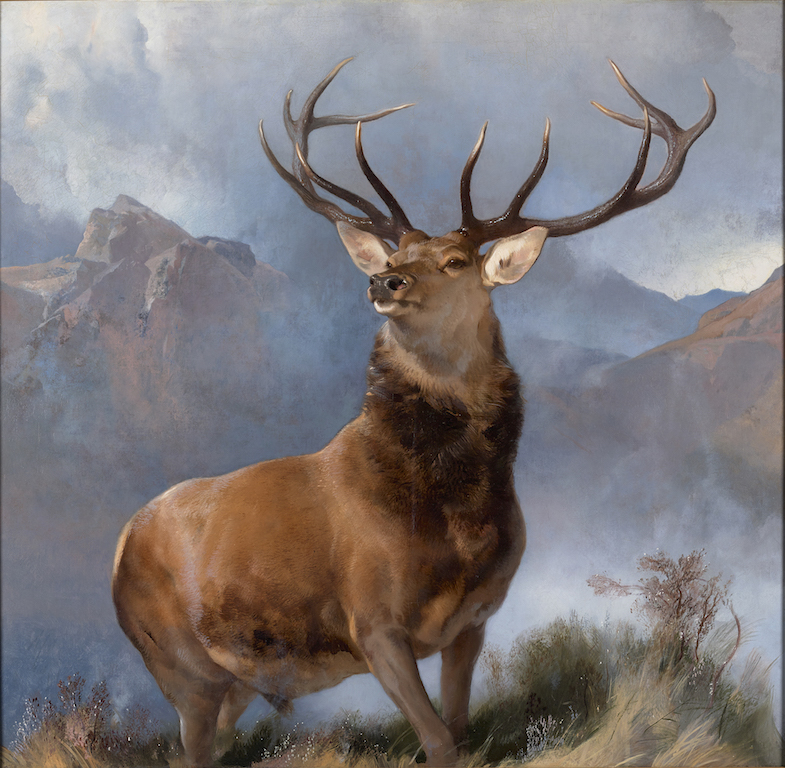Familiarity breeds contempt, which makes it difficult to look at Edwin Landseer’s The Monarch of the Glen (pictured below). The reproduction of this proud beastie on T-towels, aprons, jigsaws and biscuit tins blinds one to the subtle nuances of the original painting. Rachel Maclean’s caustic wit is a useful antidote to Landseer’s romanticised view of the Scottish Highlands, so it makes sense to visit her exhibition first.
In her film The Lion and the Unicorn (2012) the Scottish artist plays the Queen. First we see the Union Jack painted on the nail of her index finger, as she points to Great Britain on a large globe. She is like a porcelain figurine that has undergone a punk make-over involving an auburn wig, lots of lace, pearls and a Union Jack headdress and skirt. Addressing us from her library, she speaks to us in the cut-glass accents of the Queen, as recorded in her Christmas broadcast of 1957.
 The film was made in the run-up to the 2014 referendum on Scottish Independence and it takes an ironic look at the way collective identities are constructed and propagated. With the help of prosthetics, wigs and make-up, Maclean becomes the Lion of England (main picture) and the Unicorn of Scotland. Sipping glasses of North Sea oil, the pair squabble over the finances of England and an independent Scotland – in the voices of Jeremy Paxman and Alex Salmond. Meanwhile the Queen reminds us, “The union is not just about our history, but our future. A beacon of openness and tolerance, it's an idea and an ideal.” This grotesque pantomime also involves drinking the blood of a murdered Stuart upstart and eating slabs of cake iced with the Union Jack. It's a healthy reminder that the political landscape looks very different depending on which side of the border you live.
The film was made in the run-up to the 2014 referendum on Scottish Independence and it takes an ironic look at the way collective identities are constructed and propagated. With the help of prosthetics, wigs and make-up, Maclean becomes the Lion of England (main picture) and the Unicorn of Scotland. Sipping glasses of North Sea oil, the pair squabble over the finances of England and an independent Scotland – in the voices of Jeremy Paxman and Alex Salmond. Meanwhile the Queen reminds us, “The union is not just about our history, but our future. A beacon of openness and tolerance, it's an idea and an ideal.” This grotesque pantomime also involves drinking the blood of a murdered Stuart upstart and eating slabs of cake iced with the Union Jack. It's a healthy reminder that the political landscape looks very different depending on which side of the border you live.
The Queen makes another appearance in a set of tableaux vivants displayed as digital prints (pictured above right: The Queen, 2013). Accompanied by a skeleton with a red beard and with her face drenched in black tears, she is layered with cultural references such as the Maiden (of Death and the Maiden), Our Lady of Sorrows, and Queen Victoria in mourning. Another print shows Clyde, the mascot of the 2014 Commonwealth Games, baptised in North Sea oil by an English businessman on the green sward of Scottish golf links, beneath the glow of a perfect rainbow. The political and cultural mash-up would be far too rich to digest if it weren’t for the kitsch surrealism that makes these concoctions possible to swallow – just!
With one’s eyeballs seared by Maclean’s heightened colours and satirical humour, one can look again at Landseer’s painting. After his first visit to Scotland in 1824, the English artist made annual trips to sketch and hunt, so his drawings and paintings are based on actual experience as well as the anatomical studies which he began as a young student. He owned George Stubbs’ working drawings for The Seventh Anatomical Table of Muscles of the Horse, 1756-68, one of which is included in the exhibition alongside Landseer’s own closely observed drawing of a flayed dog’s leg.
 When, in 1858, he was commissioned to produce the lions for the base of Nelson’s Column in Trafalgar Square, he began sketching the animals in the zoo and even had a lion brought to his home in St John’s Wood for prolonged observation. (He also kept dogs, sheep, horses and deer in his garden: one wonders what they made of the new arrival.) The drawings on show reveal his keen eye and superb draughtsmanship; rather than portraying an animal in the wild like The Monarch, his painting of a lion conjures a beast in captivity. Seen from the side in close proximity, the powerful animal seems to be restlessly pacing its cage. The project must have been a fearsome challenge for a painter unused to thinking in the round. In a painting by John Ballantyne of Landseer working on the clay original – later to be cast in bronze by the sculptor Baron Carlo Marochetti – the artist is dwarfed by the monumental sculpture.
When, in 1858, he was commissioned to produce the lions for the base of Nelson’s Column in Trafalgar Square, he began sketching the animals in the zoo and even had a lion brought to his home in St John’s Wood for prolonged observation. (He also kept dogs, sheep, horses and deer in his garden: one wonders what they made of the new arrival.) The drawings on show reveal his keen eye and superb draughtsmanship; rather than portraying an animal in the wild like The Monarch, his painting of a lion conjures a beast in captivity. Seen from the side in close proximity, the powerful animal seems to be restlessly pacing its cage. The project must have been a fearsome challenge for a painter unused to thinking in the round. In a painting by John Ballantyne of Landseer working on the clay original – later to be cast in bronze by the sculptor Baron Carlo Marochetti – the artist is dwarfed by the monumental sculpture.
The Monarch of the Glen (1851) was painted in his St John’s Wood studio, which makes it all the more astonishing that Landseer was able to achieve such a convincing likeness. Silhouetted against a misty mountain range, the animal towers above us; if his outline seems a tad too sharp in relation to the vaporous backdrop, it is a clever fudge that, nevertheless, works. The stag sniffs the air while we lie low, as though siting him through a telescopic lens and waiting for the right moment to pull the trigger.  It seems ironic that Landseer should heroise the very animals he enjoyed shooting – the 30 pairs of antlers he had in his collection attest to his appetite for the hunt. On the other hand, if one envisages him taking aim, it makes the painting less achingly sentimental. The 12 points on the antlers indicate a “royal” stag, but rather than seeing the beast as a haughty monarch surveying his kingdom, he becomes an animal caught moments before his untimely death. As an idea, it is far too complex and interesting to be conveyed on a T-towel.
It seems ironic that Landseer should heroise the very animals he enjoyed shooting – the 30 pairs of antlers he had in his collection attest to his appetite for the hunt. On the other hand, if one envisages him taking aim, it makes the painting less achingly sentimental. The 12 points on the antlers indicate a “royal” stag, but rather than seeing the beast as a haughty monarch surveying his kingdom, he becomes an animal caught moments before his untimely death. As an idea, it is far too complex and interesting to be conveyed on a T-towel.
- Edwin Landseer & Rachel Maclean at the National Gallery to 3 February 2019, free admission
- Read more visual arts reviews at theartsdesk










![SEX MONEY RACE RELIGION [2016] by Gilbert and George. Installation shot of Gilbert & George 21ST CENTURY PICTURES Hayward Gallery](/sites/default/files/styles/thumbnail_125_x_125_/public/mastimages/Gilbert%20%26%20George_%2021ST%20CENTURY%20PICTURES.%20SEX%20MONEY%20RACE%20RELIGION%20%5B2016%5D.%20Photo_%20Mark%20Blower.%20Courtesy%20of%20the%20Gilbert%20%26%20George%20and%20the%20Hayward%20Gallery._0.jpg?itok=3oW-Y84i)




Add comment